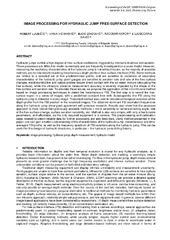Приказ основних података о документу
Image Processing for Hydraulic Jump Free-Surface Detection
| dc.creator | Ljubičić, Robert | |
| dc.creator | Vićanović, Ivana | |
| dc.creator | Zindović, Budo | |
| dc.creator | Kapor, Radomir | |
| dc.creator | Savić, Ljubodrag | |
| dc.date.accessioned | 2020-04-04T17:42:01Z | |
| dc.date.available | 2020-04-04T17:42:01Z | |
| dc.date.issued | 2019 | |
| dc.identifier.uri | https://grafar.grf.bg.ac.rs/handle/123456789/1868 | |
| dc.description.abstract | Hydraulic jumps exhibit a high degree of free-surface oscillations, triggered by intense turbulence and aeration. These processes are difficult to model numerically and are frequently investigated on a scale model. However, measuring the oscillatory characteristics of the hydraulic jump is not without issues, as the majority of available methods are not intended for tracking instantaneous depth profile or free-surface interface (FSI). Some methods are limited to a selected set of few predetermined points, and are sensitive to variations of secondary characteristics of the hydraulic jump: point gauges are sensitive to aeration rate and rate of the free-surface changes, electroconductive and optical probes require direct contact with the air-water mixture (disrupting the free surface), while the ultrasonic distance measurement accuracy is severely impacted by the shape of the free surface and aeration rate. To alleviate these issues, we propose the application of the non-intrusive method based on image processing techniques to detect the instantaneous FSI. The first step is to record the freesurface region in a series of images, with a predefined constant time shift. Subsequently, the FSI along the hydraulic jump is detected in every image. Presented method was used to reconstruct temporal evolution of the depth profile from the FSI position in the recorded images. The obtained dominant FSI oscillation frequencies along the hydraulic jump show good agreement with previous research. Results also show that the proposed approach is more robust than previously available methods – minor sensitivity to camera shooting angle, rate of the free-surface change, surface aeration variability, etc. Method is also very simple, with only a few tunable parameters, and affordable, as the only required equipment is a camera. The preprocessing and calibration steps needed to obtain reliable data for further processing are also described. Using method presented in this paper, one can gain a better understanding of the characteristics of the hydraulic jump: instantaneous and timeaveraged FSI profile, as well as the frequency spectrum of FSI variations along the hydraulic jump. This can be useful for the design of hydraulic structures, in particular – the hydraulic jump stilling basins. | en |
| dc.language.iso | en | sr |
| dc.publisher | IAHR | sr |
| dc.relation | info:eu-repo/grantAgreement/MESTD/Technological Development (TD or TR)/37009/RS// | |
| dc.relation | info:eu-repo/grantAgreement/MESTD/Technological Development (TD or TR)/37010/RS// | |
| dc.rights | openAccess | sr |
| dc.source | E-proceedings of the 38th IAHR World Congress | sr |
| dc.subject | image processing | sr |
| dc.subject | hydraulic jump | sr |
| dc.subject | depth measurement | sr |
| dc.subject | hydraulic mode | sr |
| dc.title | Image Processing for Hydraulic Jump Free-Surface Detection | sr |
| dc.type | conferenceObject | sr |
| dc.rights.license | ARR | sr |
| dc.rights.holder | IAHR | sr |
| dc.identifier.fulltext | http://grafar.grf.bg.ac.rs/bitstream/id/7131/RLjubicic_Image_Processing_for_HJ_2019-07-15_v2.pdf | |
| dc.identifier.rcub | https://hdl.handle.net/21.15107/rcub_grafar_1868 | |
| dc.type.version | acceptedVersion | sr |

